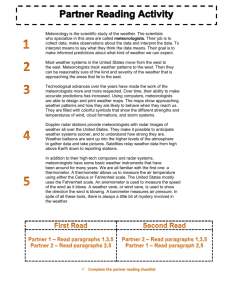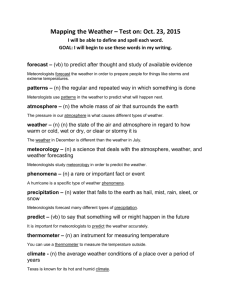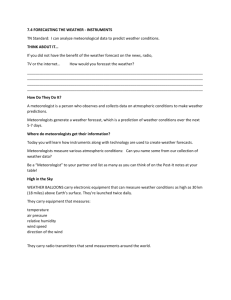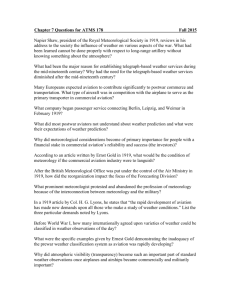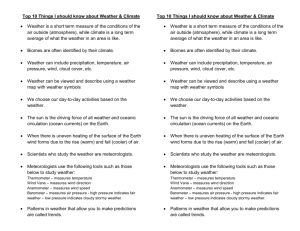Environment Canada (EC) – Meteorological Service of
advertisement
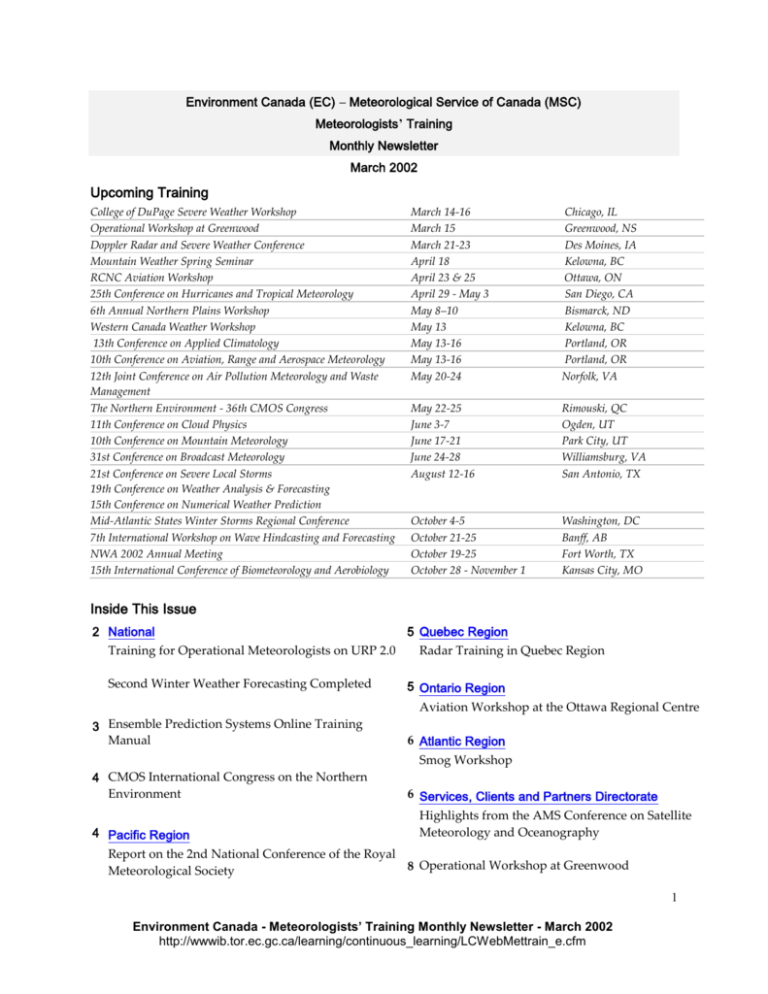
Environment Canada (EC) – Meteorological Service of Canada (MSC) Meteorologists’ Training Monthly Newsletter March 2002 Upcoming Training College of DuPage Severe Weather Workshop Operational Workshop at Greenwood Doppler Radar and Severe Weather Conference Mountain Weather Spring Seminar RCNC Aviation Workshop 25th Conference on Hurricanes and Tropical Meteorology 6th Annual Northern Plains Workshop Western Canada Weather Workshop 13th Conference on Applied Climatology 10th Conference on Aviation, Range and Aerospace Meteorology 12th Joint Conference on Air Pollution Meteorology and Waste Management The Northern Environment - 36th CMOS Congress 11th Conference on Cloud Physics 10th Conference on Mountain Meteorology 31st Conference on Broadcast Meteorology 21st Conference on Severe Local Storms 19th Conference on Weather Analysis & Forecasting 15th Conference on Numerical Weather Prediction Mid-Atlantic States Winter Storms Regional Conference 7th International Workshop on Wave Hindcasting and Forecasting NWA 2002 Annual Meeting 15th International Conference of Biometeorology and Aerobiology March 14-16 March 15 March 21-23 April 18 April 23 & 25 April 29 - May 3 May 8–10 May 13 May 13-16 May 13-16 May 20-24 Chicago, IL Greenwood, NS Des Moines, IA Kelowna, BC Ottawa, ON San Diego, CA Bismarck, ND Kelowna, BC Portland, OR Portland, OR Norfolk, VA May 22-25 June 3-7 June 17-21 June 24-28 August 12-16 Rimouski, QC Ogden, UT Park City, UT Williamsburg, VA San Antonio, TX October 4-5 October 21-25 October 19-25 October 28 - November 1 Washington, DC Banff, AB Fort Worth, TX Kansas City, MO Inside This Issue 2 National Training for Operational Meteorologists on URP 2.0 Second Winter Weather Forecasting Completed 5 Quebec Region Radar Training in Quebec Region 5 Ontario Region Aviation Workshop at the Ottawa Regional Centre 3 Ensemble Prediction Systems Online Training Manual 6 Atlantic Region Smog Workshop 4 CMOS International Congress on the Northern Environment 4 Pacific Region 6 Services, Clients and Partners Directorate Highlights from the AMS Conference on Satellite Meteorology and Oceanography Report on the 2nd National Conference of the Royal 8 Operational Workshop at Greenwood Meteorological Society 1 Environment Canada - Meteorologists’ Training Monthly Newsletter - March 2002 http://wwwib.tor.ec.gc.ca/learning/continuous_learning/LCWebMettrain_e.cfm 2 Environment Canada - Meteorologists’ Training Monthly Newsletter - March 2002 http://wwwib.tor.ec.gc.ca/learning/continuous_learning/LCWebMettrain_e.cfm National Training for Operational Meteorologists on URP 2.0 Mike Leduc, who is noted for his training sessions on the use of RADAR, is planning a series of workshops for the Regions on the new version of the Unified Radar Processor (URP) software from May through June 2002. Mike will use URP version 2.0, which is currently being finalized, in his workshops. While the concepts of working from composites, drilling down to see individual products, and cell assessment views have been introduced to most offices, a significant amount of training is still required in order for URP 2.0 to be useful to MSC meteorologists in time for the summer severe weather season. Mike is therefore planning a one-day “train the trainer” session for the week of May 6 in Toronto, with the goal of bringing in one or more trainers from each region. Beginning the week of May 13, on-site training will be provided in each region. With the main emphasis of Version 2.0 being on incorporating the functionalities of the RDSS (Radar Decision Support System), Mike initially plans to concentrate on offices that issue convective warning WUs and WFs. The draft training schedule, subject to change, is as follows: Toronto, week of May 13; CMOS, week of May 20; Montreal, week of May 27; Winnipeg, June 3; Atlantic Canada, June 10; and BC, June 17. For more information, please contact Mike Leduc at: Mike.Leduc@ec.gc.ca Second Winter Weather Forecasting Workshop Completed The Meteorological Service of Canada, in conjunction with the Cooperative Program for Operational Meteorology (COMET), held the Second Winter Weather Forecasting Course at the state-of-the-art COMET training facilities in Boulder, Colorado from February 17 to March 1. The course was held under the auspices of the recently formed MSC/COMET partnership. The aims of this partnership include moving towards establishing a more formalized approach to the professional training and development of operational forecasters in the MSC and creating closer links between the research and forecasting communities. The course was organized by Garry Toth and Peter Lewis, the two MSC meteorologists who have been assigned to work with COMET. They were ably assisted by John Gyakum of McGill University, who served as the academic course director. Representatives from all five MSC Regions, Aviation and Defence Services, and the Canadian Meteorological Centre were joined by six U.S. National Weather Service (NWS) forecasters, including three from Alaska. Course instructors included professors from leading U.S. and Canadian universities as 3 Environment Canada - Meteorologists’ Training Monthly Newsletter - March 2002 http://wwwib.tor.ec.gc.ca/learning/continuous_learning/LCWebMettrain_e.cfm well as experts from the MSC and NWS. The course built on the success of the inaugural course of 2001, with some refinements made following the course evaluations. The main focus remained forecasting hazardous winter weather, from the synoptic scale to mesoscale. Lecturers from the research community presented different ways of looking at meteorological data, such as the concept of potential vorticity and isentropic thinking. The students are eagerly awaiting the promised development of a national processing and display system that will have the ability to display and manipulate such fields. The students thoroughly enjoyed the learning experience, which was enhanced by the opportunity to socialize and renew or make new acquaintances with forecasting colleagues. The students’ enthusiasm was clearly demonstrated on the first Tuesday of the course when food and beverages for a reception was brought into the classroom at 5.00 p.m. only to be left to go cold while discussion of the afternoon’s lab exercise continued until after 5.20! Of course, a true measure of the workshop’s success will not be known until we have a chance to assess how much of this enthusiasm and knowledge has been transferred to colleagues back in the weather centres. For more information, please contact Peter Lewis, peter.lewis@ec.gc.ca, 902-426-4267, or plewis@comet.ucar.edu, 303-497-8320 (COMET-Boulder) Ensemble Prediction Systems Online Training Manual An interesting web site containing an online training manual on Ensemble Prediction Systems (EPS) targeted for NWS Weather Forecast Offices, NCEP and meteorologists wanting to know more about the ensemble technique can be found at: http://www.hpc.ncep.noaa.gov/ensembletraining/. This is an excellent manual with good graphics and clear explanations. Some of the many topics included are: Deterministic Numerical Weather Prediction Butterfly Effect Probability Density Function Plan Views: Spaghetti Plots Plan Views: Ensemble Mean Plan Views: Ensemble Mean and Spread Decile Plots Probability Plots Verification. There is an appendix of other on-line literature on Ensemble Forecasts, including one from Canada, along with a list of references. For more information, go to the above URL, or contact Peter Manousos, NCEP HPC (National Center for Environmental Prediction, Hydrometeorological Predictions Center) Science and Operations Officer, at peter.manousos@noaa.gov. 4 Environment Canada - Meteorologists’ Training Monthly Newsletter - March 2002 http://wwwib.tor.ec.gc.ca/learning/continuous_learning/LCWebMettrain_e.cfm International CMOS Congress on the Northern Environment in Rimouski Rimouski will play host to the Canadian Meteorological and Oceanographic Society’s international congress on the Northern Environment, to be held from May 22 to 25, 2002. Some 300 climate specialists will be attending the meeting, which was organized by scientists from Fisheries and Oceans Canada’s Maurice Lamontagne Institute, the Institut des sciences de la mer of the University of Quebec at Rimouski and the Eastern Quebec Weather and Environmental Services Office (WESO). Researchers from Canada, the United States and Asia will exchange information on such issues as climate change and variability, snow, ice and permafrost, carbon cycle and biochemistry, and paleoclimatology (study of the climate of the various geological periods), to name just a few. So far, over 200 oral presentations or poster sessions are planned. According to computer simulations of future climate, northern environments should be the first to show signs of global warming – melting of Arctic ice floes, a significant reduction in permafrost area, milder winters, etc. The study of nordicity and its impact on the world’s ecosystems is critical to the understanding of climate change and its environmental repercussions. Nordicity studies are of particular importance to Canada given its geographic location and northern climate. The May 2002 congress in Rimouski will provide a forum for researchers to discuss their latest research results in this field. Pacific Region Second National Conference of the Royal Meteorological Society Kent Johnson, of the Mountain Weather Centre, Kelowna, attended the Second National Conference of the Royal Meteorological Society (RMS) in Manchester, England, on September 12-14, 2001. The following is a brief summary of his report on the conference. The conference was similar in size, exhibits and composition to a CMOS Congress. The abstract book can be viewed at: http://www.royal-met-soc.org.uk/2nc. Selected oral presentations are listed below. David Burridge, president of the RMS, hosted a plenary forum, and stressed that one of the goals of the RMS is to significantly improve its contribution to national and international policy relating to the environment. Keith Browning gave an interesting and entertaining presentation on his history as a radar meteorologist. He spoke on behalf of UWERN (Universities Weather Research Network) as he is its present director. Anna Agusti-Panareda, University of Reading, gave a presentation on the extratropical transition of Hurricane Irene that passed just south of the Maritimes Weather Centre. Stephen Mobbs, of the University of Leeds, gave an interesting talk on the development of a system for forecasting lee waves over the Falkland Islands. The goal is to develop a 12-hour forecast system (www.env.leeds.ac.uk) to support aviation activity. The RMS Chartered Meteorologist Accreditation Scheme was described and discussed. Despite being coordinated with the European Meteorological Society (EMS), and despite the fact that it has been in existence for seven years, there are only 55 chartered meteorologists out of over 2000 in the 5 Environment Canada - Meteorologists’ Training Monthly Newsletter - March 2002 http://wwwib.tor.ec.gc.ca/learning/continuous_learning/LCWebMettrain_e.cfm United Kingdom (public and private sector). Keith Browning presented data and a conceptual model for the interaction of upright and slantwise convection along Ana-type cold fronts. Rachel Capon of the Met Office Joint Centre for Mesoscale Meteorology discussed the strong winds in the Dover Straits. Although the model results were interesting, it really appears to be a case of coastal convergence producing a low level jet downstream from the gap. Tim Hewson of the Met Office presented results from his objective cyclone database. He has run the scheme for one year over the Atlantic to about 80 W and would likely share the results if asked. Orographic processes were discussed in several presentations from the University of Leeds staff and students. The national vocational standards for the certification of meteorologists in the UK were discussed. To prove one’s competency, one must be assessed, and it was stated that the assessors must remain operationally competent, which might be challenging in some cases. Chris Collier, of the University of Salford, gave a short presentation on the current status of quantitative precipitation forecasting (QPF). Verification scores seem to show that there has been no improvement over the last 30 years. Kent Johnson gave a talk on slantwise convection. Vicky Lucas, Met Office College, indicated that this topic is not part of their curriculum, but probably should be. In his report, Kent offered the opinion that MSC and the U.K. Met Office share as many scientific and logistical challenges as does MSC and the U.S. National Weather Service, and suggests that, should a similar event be sponsored by the RMS, MSC may wish to consider participating. For more information, contact Kent Johnson at (250) 491-1532. Quebec Region Radar Training in Quebec Region Radar is of great importance to the Quebec Region, and several workshops on radar are planned for this spring: Rimouski already had a radar workshop on February 5 and 7 of this year. Dates are yet to be determined for future workshops in Quebec City and Montreal. A forecaster from each weather centre in the Quebec Region will attend training on the new version of the URP (Unified Radar Processor) in Toronto on May 7 and 8. All severe weather specialists from the Montreal Weather Centre will attend a radar workshop offered by Mike Leduc on May 27. For more information, contact Guy Roy at (418) 648-7565. Ontario Region 6 Environment Canada - Meteorologists’ Training Monthly Newsletter - March 2002 http://wwwib.tor.ec.gc.ca/learning/continuous_learning/LCWebMettrain_e.cfm Aviation Workshop at the Ottawa Regional Centre A one-day aviation weather workshop will be held April 23rd and 25th at the Ottawa Regional Centre primarily for office staff. The workshop will deal with the following topics: FIC and FSS feedback on TAF’s and GFA’s by Mike Masek and Joanne Lancaster (NAV CANADA ). TAF writing guidance and proposed format under different summer situations (various convective scenarios, fog, etc, including exercises (Alister Ling, TAF Quality Improvement Meteorologist from PNR). New guidance software (TAFaid and TAFTOOLS) (Alister Ling) Short term forecasting techniques/ Lake breeze/Challenges with AWOS sites (Geoff Coulson, RCTO) Ontario Region contingency plan and TAF verification (Geoff Coulson) The workshop will be held in the Ice Centre Training Room located at the ground floor of La Salle Academy. Space is limited, so those wishing to attend, please contact Stan Siok (stan.siok@ec.gc.ca or tel.: (613) 990-2005) Atlantic Region Smog Workshop The New Brunswick Weather Centre (NBWC) will be holding a Smog Workshop on May 21, with a repeat on May 23. The intent of this workshop is to provide an opportunity for the NBWC operational staff to gain further insight and experience into smog behaviour. With a focus on ground-level ozone and fine particulate matter, this daylong workshop will be evenly divided between classroom instruction and “hands-on” activities. Topics to be covered include climatology, verification, current/new programs and forecast methodology and procedures. For further information contact: Michael Howe at (506) 451-6015. Services, Clients, and Partners Directorate Highlights from the AMS Conference on Satellite Meteorology and Oceanography The American Meteorological Society (AMS) held its 11th Conference on Satellite and Meteorology and Oceanography in Madison, Wisconsin, on October 15-18, 2001. Barry Konzelman of the Training Services 7 Environment Canada - Meteorologists’ Training Monthly Newsletter - March 2002 http://wwwib.tor.ec.gc.ca/learning/continuous_learning/LCWebMettrain_e.cfm Unit (TSU) at the Canadian Forces School of Meteorology (CFSMet) attended the conference and wrote a report on it, a brief summary of which is provided below. The conference consisted of a small number of rather prestigious speakers with 30-45 minutes each to speak, followed by longer poster sessions. There were very few Canadians present at the conference, either as participants, presenters, or as corroborators in international efforts. However, many countries, in addition to the U.S., did have a significant presence. Because remote sensing with satellites will soon become of paramount importance in many aspects of meteorology, a strong theme of the conference was ingesting satellite data into NWP (Numerical Weather Prediction) models, a topic in which CMC is clearly interested. Some points of interest were as follows. It is envisaged that there will be an integration of some satellite systems between organizations and countries. The NPOESS (National Polar Orbiting Operational Environmental Satellite System) is a collaboration between the U.S. and other national weather services to share polar orbiting satellites. It is expected there will be 50 new instruments flying on satellites launched in the next 10 years, with much emphasis on sensing longer terrestrial wavelengths (13-18 microns). Currently about 84% of the information input into NWP models is remotely sensed, and one speaker said that when radar information gets into U.S. models, that figure will rise to 99%! Some researchers feel it is better to input radiances straight into the models, rather than derived temperatures. An Australian weather service representative, for instance, said that if the upper air data were missing, it would only make a 1% difference in their model accuracy. Satellite data is already much more important than the ground-based reporting network. Lynn K. Shay of the University of Miami spoke on the use of radar altimetry to identify warm rings in the Gulf of Mexico which were warm to a great depth, resulting in a “high” of about 30 cm in the ocean surface topography. It was found that when hurricanes travelled over deep warm rings, the hurricanes strengthened significantly. Normally, a cooling of the surface water occurs when hurricane-force winds mix up colder water from below, reducing the potential strength of the hurricane. With deep warm rings, the surface remains warm, strengthening the hurricane. The study showed that the depth of the 26°C isotherm was a better tool than surface temperature for forecasting the intensification of hurricanes. An analysis of ocean heights could also be used to analyze warm and cold eddies associated with the Gulf Stream off Canada’s East Coast. The session on global climate monitoring raised many problems, including how orbital decay over time affects the angle of incidence of the satellite sensor relative to the Earth, and how the local time of passage changes over time, which affects studies of precipitation amount, which has a strong diurnal cycle. The lower orbit also affects the temperature of the instruments on the satellite, which affects their response. In addition to instrument changes on different platforms, instrument calibration also drifts over time. On the whole, it is very difficult to gauge earth radiation changes, since the aforementioned calibration factors outweigh the changes in terrestrial radiation which have occurred over the time period of the data set. 8 Environment Canada - Meteorologists’ Training Monthly Newsletter - March 2002 http://wwwib.tor.ec.gc.ca/learning/continuous_learning/LCWebMettrain_e.cfm Contrails and the corresponding increase in cirrus cloudiness are becoming a regional factor in radiation transfer and heat budget, besides being an immense tactical problem for military aircraft. It is still difficult to automatically detect the difference between ice in cloud and snow or ice on the surface. However, Ms. Masutani of NOAA said that, by 2008, new instrumentation flying on the NPOESS satellites will make it possible to accurately detect the difference between the two, a significant advantage when trying to analyze mid to high latitude satellite data. With the launches of new series of satellites with new sensors, the data flow will increase by a factor of 105. Some new products will include surface winds every 15 minutes over the entire water surface of the earth, soundings of 4 km resolution at a rate of 100,000 soundings per minute at great vertical resolution, turbulence detection in clear air, precipitation estimates, total column water vapour, fog depth, severe weather indices and time resolutions of 10 seconds for thunderstorms. Remote sensing from satellites will increase very substantially over the next 10 years and incorporating the new data into environmental monitoring and forecasting will be a challenge. Barry states that it is important that EC personnel attend meetings such as this in order to benefit from and hopefully influence such leading edge discussions. For more information, contact Barry Konzelman at (204) 833-2500, Ext. 5420. Operational Workshop in Greenwood An operational workshop is being planned for Friday, March 15 at WSC (Weather Services Centre) Greenwood, prior to the “20th Annual Broken Broom Bonspiel” to be held the next day. The purpose of the workshop is to provide an informal forum in which meteorology folks can discuss operational topics. A three-hour Doppler Radar refresher will be given by Barry Konzelman of the Canadian Forces School of Meteorology (CFSMet) and repeated at WSC Halifax on the following Monday and Tuesday. Other topics may include: Overview of GRIB/BUFR; Update on lightning data; Use of the new Met Manager/AMX; and Package-building in the CF (Canadian Forces) Weather Office Web service. Attendees from other locations--meteorologists, IT staff and meteorology technicians--are invited. Contact: Bob Howell, (902) 765-1494, Ext. 3142. Readers are encouraged to submit articles related to learning, training and recruitment. Submissions or any questions related to items without a contact can be directed to Spencer.Silver@ec.gc.ca Editorials: If you would like to express an opinion or submit a commentary, please send your comments to Spencer.Silver@ec.gc.ca 9 Environment Canada - Meteorologists’ Training Monthly Newsletter - March 2002 http://wwwib.tor.ec.gc.ca/learning/continuous_learning/LCWebMettrain_e.cfm
